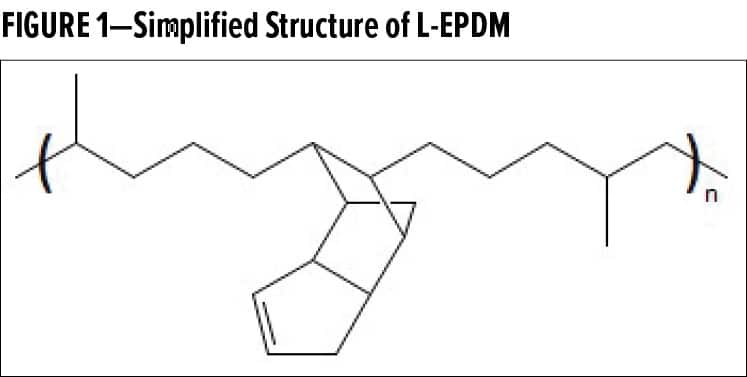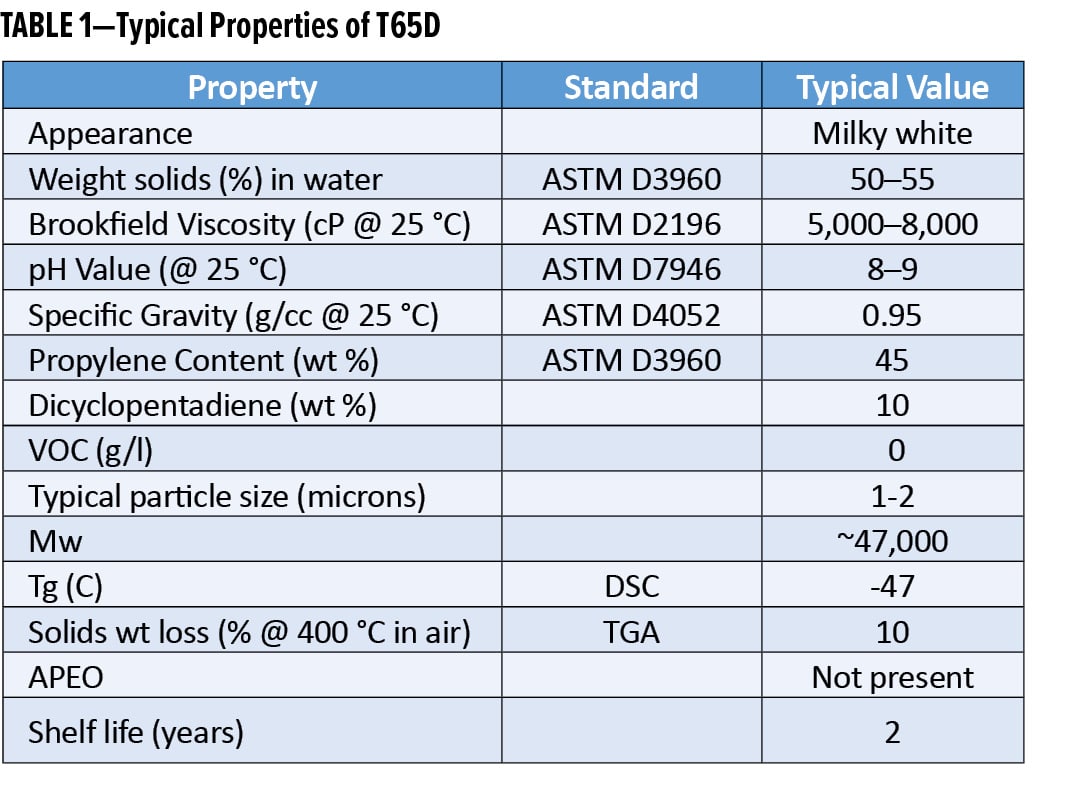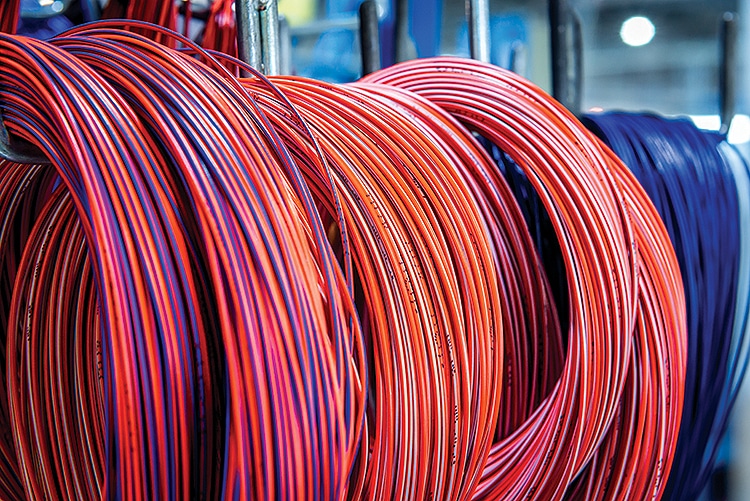By Gregory J. Brust and John D. Jacquin, Lion Elastomers
Liquid ethylene propylene diene rubber (L-EPDM) has been known in the coatings industry for many years. These elastomers have found utility in ambient cure liquid-applied roof coatings. These resins, formulated into waterborne liquid coatings, may be cured with peroxides, metal driers, or UV radiation and can be used in ambient maintenance coatings for flat or low-slope roofs.
 Recently, formulations blending the L-EPDM (Figure 1) with other common coatings resins have been developed. Elastomeric acrylics, alkyds and polyurethanes have been blended with the L-EPDM without the use of compatibilizers. Each of these systems has seen unique property improvements, such as surface wetting, adhesion, impact strength, and more.
Recently, formulations blending the L-EPDM (Figure 1) with other common coatings resins have been developed. Elastomeric acrylics, alkyds and polyurethanes have been blended with the L-EPDM without the use of compatibilizers. Each of these systems has seen unique property improvements, such as surface wetting, adhesion, impact strength, and more.
Additionally, industrial heat-cure formulations have been developed for a broad range of temperatures. This paper will discuss L-EPDM waterborne suspension and blend properties, coating formulation, application and curing methods, and final film properties.
INTRODUCTION
Ethylene-Propylene Diene (EPDM) rubber has been used extensively in automotive, wire and cable, roof membrane, and thermoplastic vulcanite (TPV) applications because of the ease of processing due to the polymer’s unique structure. 1,2
Many of the properties of EPDM, notably, ozone and UV resistance, low-moisture permeability, and excellent high- and low-temperature properties, make it an ideal material for exterior coatings. In recent studies, three coating formulations from a commercially available low-molecular-weight liquid EPDM (L-EPDM) were demonstrated; a peroxide crosslinking mechanism and a sunshine UV crosslinking mechanism, and a dual-cure system that uses both peroxide and UV. 3,4,5
These formulations all generate good EPDM rubber properties after crosslinking, including high mechanical strength, low-temperature flexibility, hydrophobicity, and adhesion to polar substrates. The formulations meet industrial requirements as protective coatings in solid content, rheology, curing speed, shelf life, pot life, and can be produced at a cost consistent with commercial elastomeric acrylic coatings.
These coatings were also formulated to be used as liquid roofing membranes and showed improved performance over solid EPDM sheets and elastomeric acrylic coatings in terms of ease of installation, solar reflectance, water resistance, and weather durability.
A previous paper reported on a waterborne dispersion of L-EPDM used for coatings and adhesives.6,7 L-EPDM dispersion used in this study is Trilene® 65D (T65D). T65 is a low-molecular-weight polymer of EPDM consisting of 45 wt % ethylene, 45 wt % propylene, and 10 wt % dicyclopentadiene monomers.
When blended with surfactants and dispersed in water at 50–55 wt % solids, it is designated T65D. Properties of T65D are shown in Table 1. The paths to formulating a peroxide-cured, a sunshine-UV cured, and an oxidatively cured system were discussed. The mechanical properties approach their solventborne counterparts.
These low-VOC coatings retain the low-temperature flexibility, hydrophobicity, excellent adhesion, and low-water vapor transmission. It was also shown that by blending this L-EPDM dispersion with commercially available elastomeric acrylics, improved wetting over low-energy substrates and in increase in tensile modulus is achieved.
This work demonstrates the ability of this L-EPDM dispersion to be blended with other common waterborne coatings resins. Several new formulations using this dispersion are also discussed, including direct to metal and high temperature industrial coatings. New formulations using the L-EPDM dispersion as a co-binder with waterborne acrylates and alkyds are also presented.
CONTINUE READING IN THE AUGUST 2021 DIGITAL ISSUE OF COATINGSTECH
REFERENCES
- Karpeles, R., and A. V. Grossi. “EPDM Rubber Technology,” Handbook of Elastomers, 2nd ed., New York, 2001, 845.
- Riedel, J. A. and R. V. Laan. “Ethylene Propylene Rubbers,” The Vanderbilt Rubber Handbook, 13th ed., Norwalk, CT. 1990, 123.
- Molnar, M. J. ; Nelson, D. S.; Fontenot, A. J.; Young, H. W.; Ibay, J. A. U.S. Patent 8,962,724 B2, 2015.
- Molnar, M. J. ; Nelson, D. S.; Fontenot, A. J.; Young, H. W.; Ibay, J. A.; Zhu, Z. U.S. Patent 8,901,194 B2, 2014.
- Molnar, M. J. ; Nelson, D. S.; Fontenot, A. J.; Young, H. W.; Ibay, J. A. U.S. Patent 8,901,191 B2, 2014.
- Brust, G. “Liquid EPDM for Waterborne Coatings” The Waterborne Symposium. 27 February 2019.
- Brust, G. Paint & Coatings Industry, 2019, 35(9), 32.
- Brust, G., and J. Jacquin. “New Waterborne Coatings Formulations with Liquid EPDM” The Waterborne Symposium. 10 February 2021.
CoatingsTech August 2021 | vol. 18, no. 8
